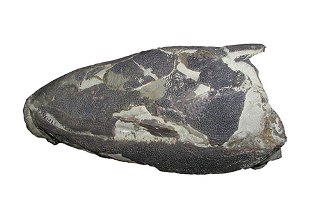Aug 24 2015
Dr Laura Porro and colleagues in Bristol’s School of Earth Sciences and at the University of Cambridge applied high-resolution X-ray computed tomography (CT) scanning to several specimens of Eusthenopteron.
 One of the original skulls used in the project Dr Laura Porro
One of the original skulls used in the project Dr Laura Porro
This prehistoric fish grew up to 1.8 metres (6 feet) in length and patrolled shallow lagoons 385 million years ago during the Late Devonian period.
The researchers used cutting-edge software to digitally strip away rock from fossil bone and separate individual bones and teeth from each other. The aim of the study was to better understand the lower jaw of Eusthenopteron, which had never been fully described. As they ‘digitally dug’ deeper, however, researchers found a surprise in the shape of a new jaw bone.
Eusthenopteron is what is known as a lobe-finned fish and is important in evolutionary terms as it is related to the first tetrapods. Tetrapods are the four-footed vertebrates that took their first steps on land nearly 20 million years later during one of the great transitions in the history of life.
It is crucial for understanding why vertebrates moved out of water and onto land in the first place. The fossil is not new to science and was first described in 1881. Since its initial description, thousands of specimens have been discovered, making it one of the best known fossil fish.
Lead author, Dr Porro, now at the Royal Veterinary College (RVC), said: “While examining CT scans of multiple specimens of Eusthenopteron, we kept finding a long, thin bone near the front of the lower jaw that we could not identify. It just isn’t one of the ‘standard’ bones that make up the lower jaws of either lobe-finned fish or tetrapods.”
It turned out that the structure had been noticed in other species of lobe-finned fish and tetrapods, but was assumed to be either a broken fragment or an extension of surrounding bones. In fact, CT scans demonstrate it represents a bone entirely new to science, which the authors of the study have called the ‘postsymphysial’ because it occurs immediately behind (‘post’) the area where the right and left halves of the lower jaw come together (‘symphysis’).
While the bone occurs in several other lobe-finned fish and tetrapods, its presence in the lower jaw was short-lived. “By the time tetrapods made their final move onto land at the end of the Devonian and beginning of the Carboniferous, the postsymphysial disappears,” Dr Porro added.
Additionally, the study found new clues to how Eusthenopteron captured its prey. Earlier studies suggested that because of its strong, fish-like appearance, Eusthenopteron captured its prey the way most modern fish do – using suction. The size and distribution of its teeth and the shape of contacts between individual bones, however, suggest it may have also used a strong bite to tackle larger prey.
The researchers are applying these methods to other early tetrapods to learn more about their anatomy and ecology. Digital models are also useful for education and scientific research, as they can be easily accessed by people around the world.